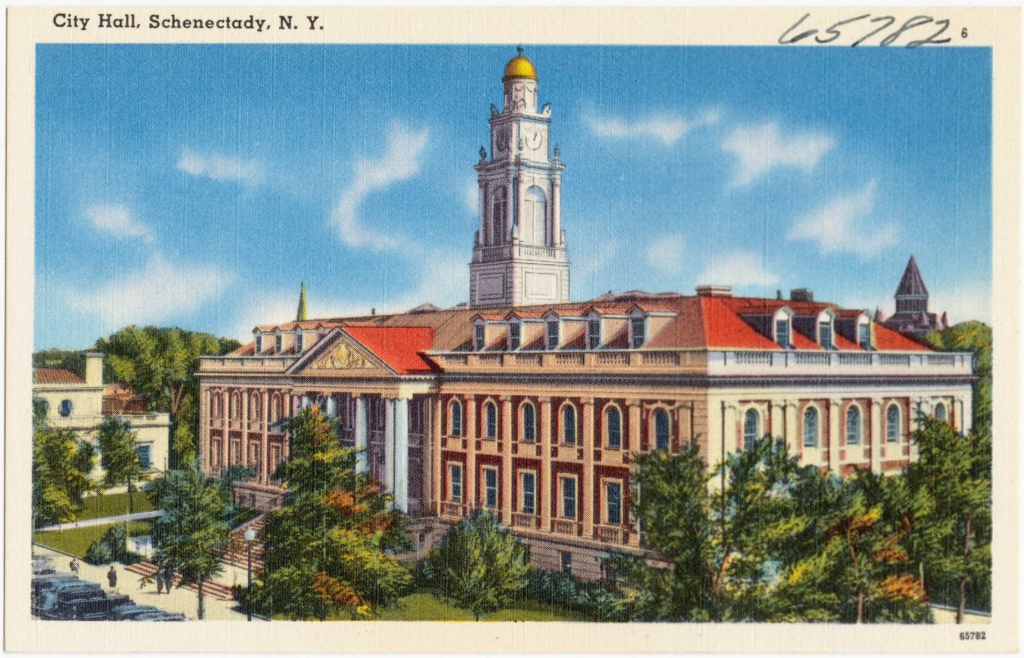 This is a postcard view of Schenectady’s City Hall, the classic Federalist hall designed by McKim, Mead & White and constructed 1931-1933. MMW won a competition among seven firms, three from Schenectady. Some elements of the design were actually prescribed by the city, which apparently wanted something that would complement the Post Office and would echo the legacy of Albany’s most prominent architectural figure, Philip Hooker: “Harvard brick and Vermont marble are proposed as the building materials for the external walls, and Vermont slate for the roof. The design has been developed in the manner of Philip Hooker, whose work represents such an important part of the early architectural heritage of this locality.” So the Gazette wrote on May 10, 1930, when the cornerstone was laid.
This is a postcard view of Schenectady’s City Hall, the classic Federalist hall designed by McKim, Mead & White and constructed 1931-1933. MMW won a competition among seven firms, three from Schenectady. Some elements of the design were actually prescribed by the city, which apparently wanted something that would complement the Post Office and would echo the legacy of Albany’s most prominent architectural figure, Philip Hooker: “Harvard brick and Vermont marble are proposed as the building materials for the external walls, and Vermont slate for the roof. The design has been developed in the manner of Philip Hooker, whose work represents such an important part of the early architectural heritage of this locality.” So the Gazette wrote on May 10, 1930, when the cornerstone was laid.
There’s a copper box behind the cornerstone, 10 inches wide, 14 inches long, and 8 inches deep. A committee of city officials and a number of clergymen was charged with deciding what would go in that box, and to judge by this report from the Gazette on April 24, 1930, they decided that everything should.
“The committee wishes to place in the copper box, which will be hermetically sealed, as many interesting souvenirs of the present day as the box will contain. A great many of the documents and articles proposed have connection with the city hall project. The committee has decided to place in the box the following articles, and more, should the space warrant it: Copies of stories which appeared in the “American City” magazine of August, 1929, and the “Architect” of June, 1929, both dealing with the architectural competition for the design of the new city hall; copies of the two daily newspapers of an issue as near the date of May 10 as the sealing of the box will allow; a general description of the movement for the new building and its final realization; photographs of the city hall plot as it appeared before the old buildings were razed; photographs of the old city hall and city hall annex; photographs of all the plans in the architectural competition; photographs of principal buildings of the city, such as Union College structures, schools, library, Elks’ clubhouse, banks, Hotel Van Curler, principal industries and postoffice [sic] building, as well as views of the great western gateway, Erie boulevard, State street, etc.; as many aeroplane views as may be accessible; a copy of The Atlas.
“A detailed map of the city in 1875 on which the buildings are sketched to detail; copy of the official common council manual which describes the city government, its history and present personnel; a copy of the 1930 municipal budget; historic sketches of the American Locomotive, General Electric and Mica Insulator Company plants; a book entitled “Schenectady and Great Western Gateway, Past and Present,” published by the chamber of commerce at the time of the bridge’s opening and which contains articles written by Dr. James H. Stoller, professor emeritus of geology of Union College; DeLancey W. Watkins, then president of the Schenectady County Historical Society; Postmaster Edwin G. Conde; Willis T. Hanson, jr., Dr. Charles Alexander Richmond, former president of Union College; George W. Featherstonhaugh, Frederick L. Bronner, former Mayor [T. Low] Barhydt, John W. Hammond and Myron F. Westover; the 1929 report of the chamber of commerce.
“A booklet published by the chamber of commerce entitled “A General Survey of Schenectady” and containing economic and industrial data; a 1,000-foot photophone reel, a production of the General Electric Company which details the steps in the movement for the new city hall, including such scenes as Mayor Fagal’s signing the ordinance providing for the construction of the new building, the board of estimate and apportionment at the session during which it approved the ordinance, with remarks by all the members; the board of aldermen leaving the old city hall after its last meeting in that building, and the police leaving the building preparatory to occupying their new headquarters, Smith and Clinton streets; and possibly the full contents of the copper box which was enclosed in the cornerstone of the old city hall.
“In choosing the articles to be enclosed in the cornerstone, the committee is being guided by the thought of what will be of the most interest to those who may open the box a century or more hence.”
It hasn’t been quite a century. Generally, time capsules don’t do too well, but there have been exceptions (like one in Boston that survived a century in beautiful condition), and I’d sure love to see that photophone reel.

1 thoughts on “The Time Capsule in Schenectady’s City Hall”